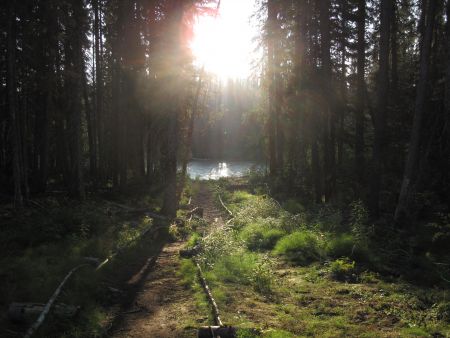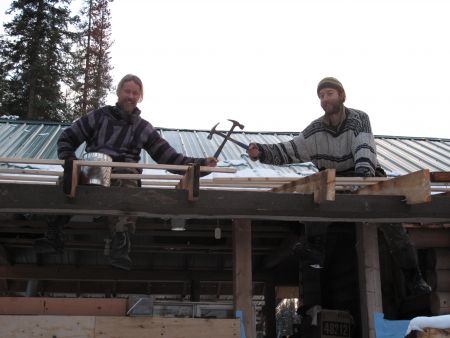The other day I was watching videos of the Tar Sands Blockade where environmentalists were resisting the path of the Keystone XL pipeline in Texas. In a recent series of direct actions activists there have deployed ingenious configurations of tree-houses, platforms, ropes and banners erected and organized in an almost ‘Ewok-style’ resistance. These remarkably well-organized actions have created enthusiasm and inspiration for many, and for me evoked reflection and brainstorming strategy.
These eco warriors were able to delay for two days loggers clearing the right-of-way for the Keystone XL pipeline. After they were removed and arrests handed out, they returned further up the route and set up the tree resistance yet again to force industry and police to go through the same process of removal a few days later. This way the delays and the complications continue for industry, and so does the necessity to dispense time, money, and resources time and again to remove the disruptions. If these efforts continue and multiply themselves in frequency and into different areas, it gets more and more difficult for industry to operate. With environmentalists, and more prominently and importantly indigenous communities resisting on the frontlines, industry is forced to employ either private security contractors or to turn to the state in order to remove the activity disrupting business. This gradually begins to affect industry’s bottom-line, and as for the state, it is forced into the uncomfortable and politically precarious position of having to use repression against “citizens.” Eventually the cumulative impacts of this resistance will begin to show results and become a deterrent to the further expansion of industrial infrastructure.
For its part, the state is now bracing for increased opposition and resistance to industrial and extraction projects. The Canadian government’s new deal with China, the Canada-China version of FIPA (the Foreign Investment Protection Agreement) effectively guarantees China’s investments. Those investments are in the form of natural resource extraction in the north, namely in Quebec and British Columbia, and in oil and gas flowing to the west coast via the would-be Northern Gateway and Pacific Trails Pipelines. China does not have direct investment in Northern Gateway and Pacific Trails, although much of that oil and gas will be going to Chinese markets. It is, however, invested in a consortium of companies called LNG Canada including Shell Canada, KoreaGas, Mitsubishi corporation and PetroChina for an LNG (Liquid Natural Gas) processing plant in Kitimat, BC, and a pipeline called the Coastal Gas Link project to be built by the now notorious TransCanada corporation, the same company contracted to build the Keystone XL.
Through FIPA amongst other measures, the Canadian government is building justification in the name of economic stability and the rule of law and setting the framework for the increased criminalization and repression of internal dissent. Under this new set of draconian circumstances the government guarantees itself the right, the privilege, and the obligation to suppress environmental and native resistance to extraction projects and industrial infrastructure. The Canadian state is further institutionalizing the rights of profit-making and corporations over the rights of people and the environment. The increased militarization of the state worldwide, therefore, is not a measure of security against outside threats, but rather a very deliberate act to exert force and control within its own borders.
Last year in November, president Obama denied an application for the 1,700 mile long Keystone XL Pipeline that would bring Tar Sands oil from Alberta, to Texas refineries on the Gulf Coast. In December, I wrote on Rabble.ca, “having too much faith that the U.S. government will make the right decision on an environmental matter, and being under the illusion that the decision will be subject to a thorough scientific review and "truly public input process" would be a mistake. Celebrating a perceived victory which is actually closer to a setback is not a good idea…. And finally, the only reason why the Keystone XL decision has been postponed is because Obama and company don't want it to be an issue come election time in 2012…Those from the ENGO community overreacting to the Keystone XL postponement as a victory, misinterpreting the situation, are actually doing the climate justice movement a considerable disservice.” Now, with the clearing of the right-of-way for the pipeline moving full steam ahead, the so-called “Keystone XL victory” is, quite predictably, rearing its ugly head.
In the US, the Republicans have promised that they will do everything in their power to ensure that the Keystone XL Pipeline goes through. TransCanada corporation, for its part, anticipates approval of the presidential permit application, which is required only as the pipeline crosses the Canada/U.S. border, in the first quarter of 2013. Even though it is unlikely that the pipeline will be that far along by April of next year, it is clear that industry is using loopholes and sheer insolence to force through industrial projects even though it still does not have full approvals. This is an indication that industry is trying to ram through the final phase of industrial capitalism and the destruction of the earth, with or without the state’s approval. What remains of the life systems of this planet, the ecological world, is now ground zero for the unchecked expansion of industrial infrastructure.
It is under this context that Damien Gillis and the team for the documentary film Fractured Land recently named the threatening advances of industry in northern BC, and other provinces, as “Canada’s Carbon Corridor.” I will add to that Canada’s ‘Colonial’ Carbon Corridor because environmental racism and the exploitation of indigenous peoples has always been a central feature of the Canadian state’s application of the industrial capitalist economy. What is meant by ‘Carbon Corridor’ is the expanded and systematic industrialization and exploitation of the Canadian North; the integrated impacts of industry from all of mining, oil and gas, fracking, logging, hydro-electric damming, new highways, etc. A major component of capitalism’s plan moving forward is the transformation of entire zones into industrially-facilitated natural resource reservoirs.
It is from this brazen devastation of nature that the need arises for something just as audacious to counter it. We must put life and creativity in the place of aggression and destruction. On Wet’suwet’en territory in what is colonially known as northwest British Columbia, grassroots community members of the Cilhts’ekyu (Unis’tot’en), and Likhts’amisyu clans have re-occupied their traditional unceded territory to resist the Pacific Trails pipeline. Their means of resistance has been community-building.
The Pacific Trails Pipeline (PTP) is the intended trailblazer of a prospective ‘energy corridor’ that would see multiple dual pipelines stretch 463km from fracking fields in eastern and northeastern BC, all the way to the Douglas Channel on the west coast. Like the Coastal Gas Link project the Pacific Trails pipeline would carry shale gas and would also target LNG processing terminals in Kitimat and tankers bound for Asian markets. PTP could be as much as three kilometres wide and threatens ecological damage along a trail of wetlands, streams, forests, native communities and farmland along the way.
As such, the grassroots Wet’suwet’en have committed that no pipelines will cross through their territory. But what is now unfolding on their land is not simply resistance to a pipeline and the defense of a territory, but the building and rebuilding of a radical alternative and traditional living. That is why such a strong emphasis at camp has been placed on community building and empowerment so that organizing and resistance can be integrated into the spaces of everyday life. This is pre-figurative organizing that confronts an injustice by counteracting it with a direct alternative. The resistance community, therefore, is the illustration that building and creating is the most comprehensive form of resistance, that there is no separation between life, and the defense of life.
The extraction and industrial development boom in the north is really a strategic plan of components where inter-industry cooperation sees a combined effort, for example, that would see LNG flowing via westbound pipelines and condensate flowing back east as a petro-chemical dilutant for tar sands bitumen, hydro dams providing energy for mining and oil and gas extraction, highways being built for all of industry, etc. That is why all these struggles and resistance fronts cannot be understood separate of each other, and why the collective response must leave no community behind along the pipeline routes and the path of industry. These resistance communities can be effective by operating through a well-coordinated and well-organized network. This network should link anarchists, permaculturalists, native and farming communities alike on a basis of trade, collective support, and mutual aid. Set up these established and organized communities who are all working together in mutual defense, and have the state and industry face the same time-and-resource-consuming challenges every few kilometres, over and over again. Community is attrition against the privatization and enclosure of territories.
Where industry says it will build energy corridors we will build community corridors in its place. The movement must move from isolated blockades and direct actions, as bold as they may be, to actively building radical alternative communities, resistance communities, directly in the path of extraction and industrial infrastructure. Environmentalists, with indigenous communities in the lead, must collaborate to establish fully permanent communities, self-sustaining and autonomous from the industrial system in order to be genuinely effective in resisting it. Where the Northern Gateway pipeline seeks to pass, where the Kinder Morgan, the Coastal Gas Link, the Pacific Trails, the Keystone XL and all other pipelines seek to cross, the movement must build community corridors in their paths. The resistance spokes cannot be simply passive and sparse direct action blockades, but rather fully intentional and deliberate permanent communities everywhere. Let us saturate the pipeline routes with radical community all along the corridor, at every kilometer, at every turn. Stop the industrial veins and the black blood of the capitalist economy will not flow.
Julien Lalonde is a writer and community organizer who focuses on ecological justice, horizontal organizing, and creative resistance. He is currently exploring alternative communities across Turtle Island with friend and organizing partner Brett Rhyno. Julien is currently based out of Wet'suwet'en territory and blogs at culturesofresistance.wordpress.com.





